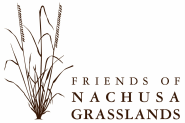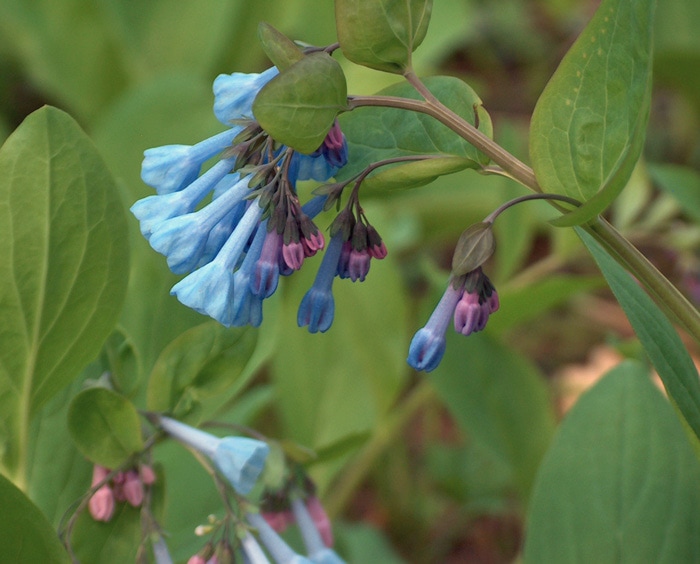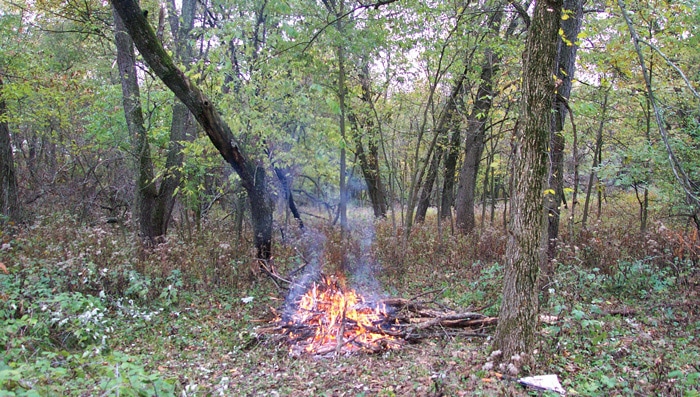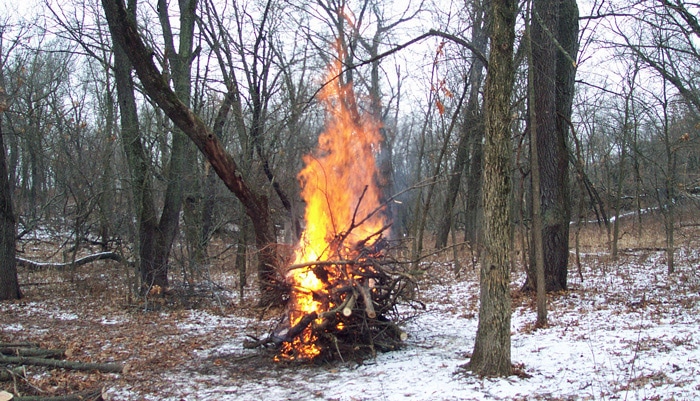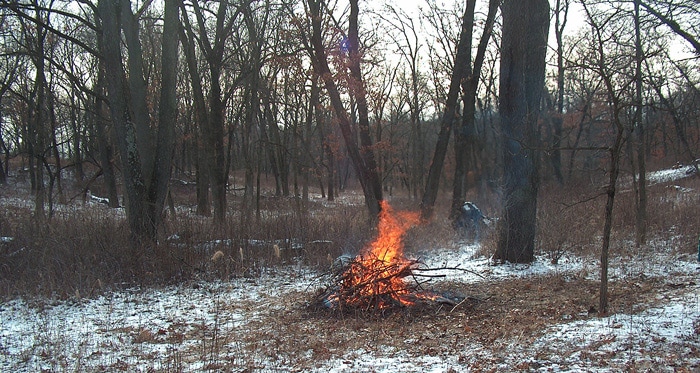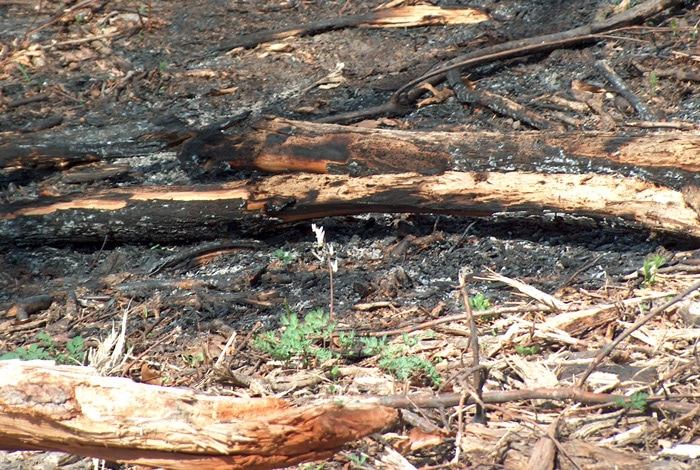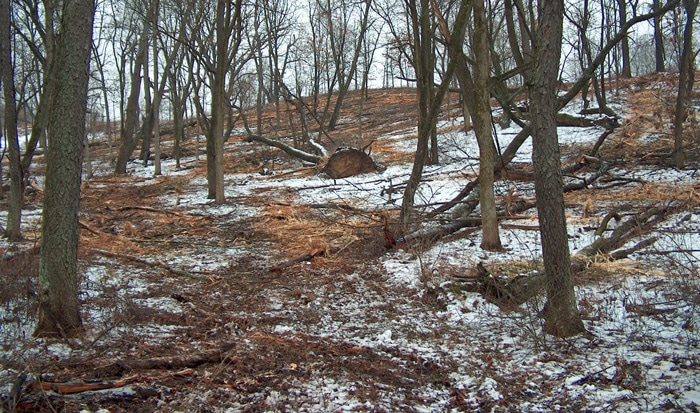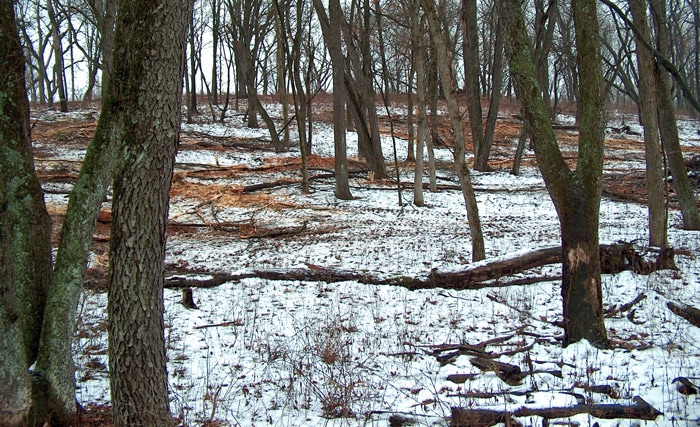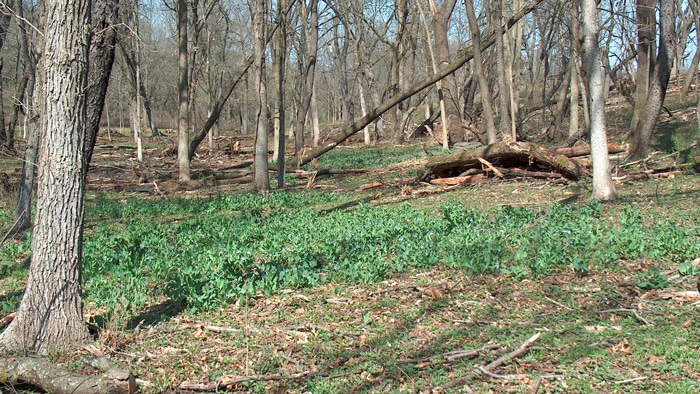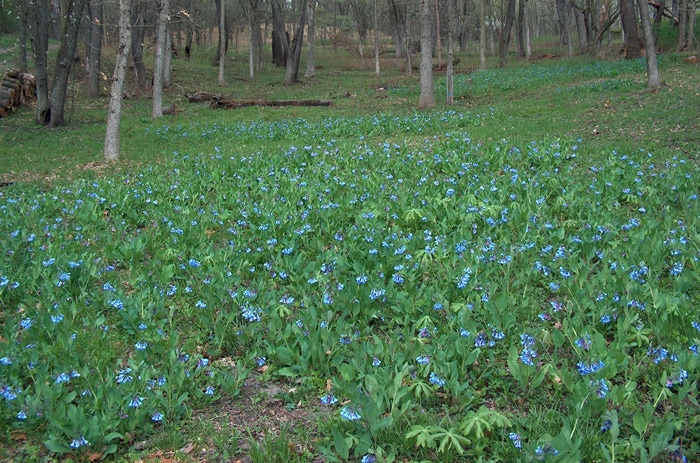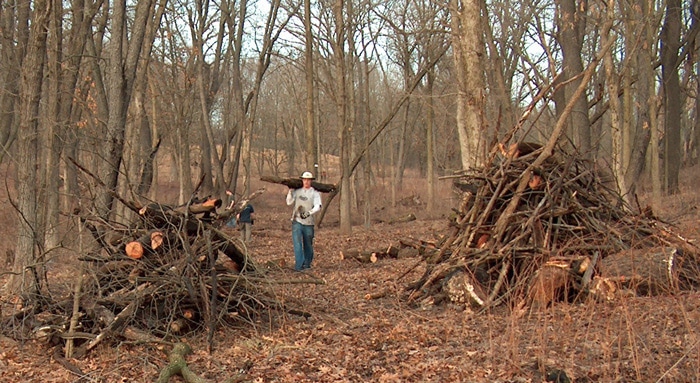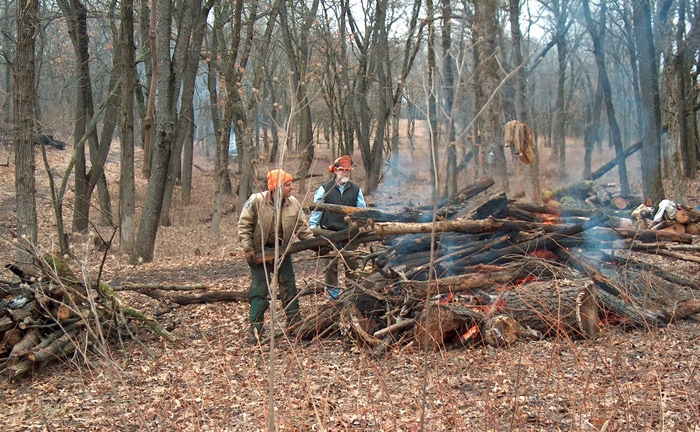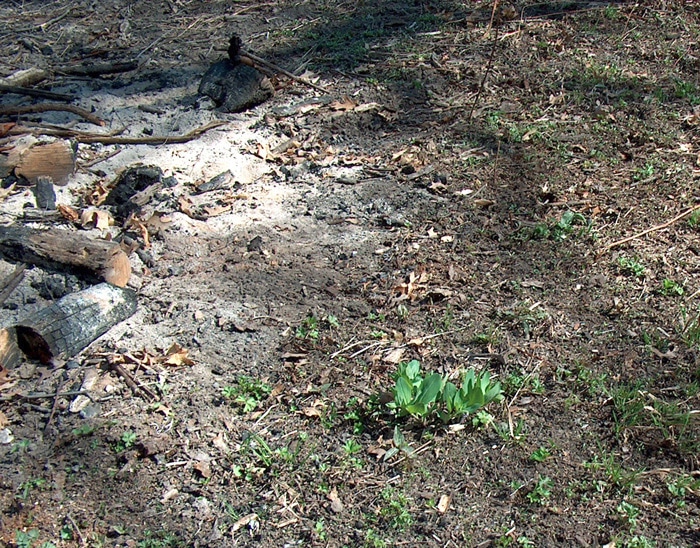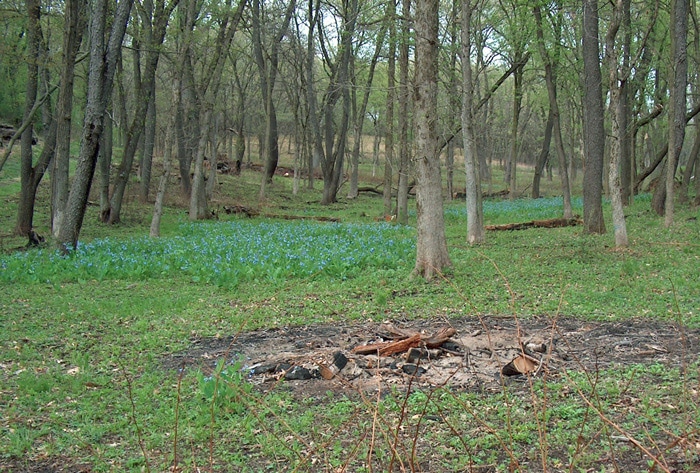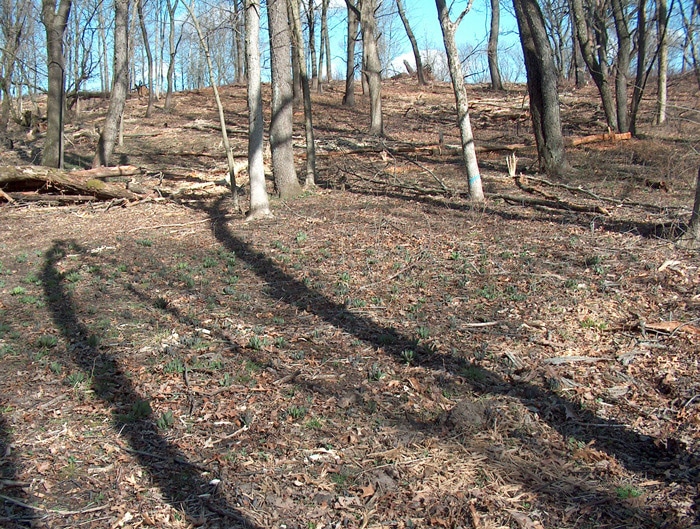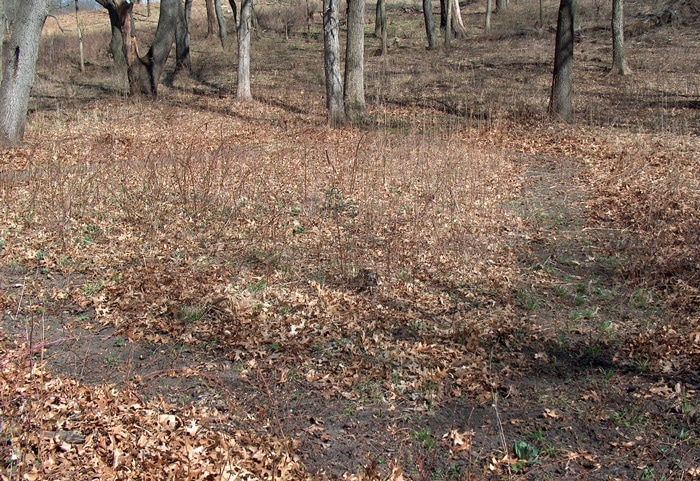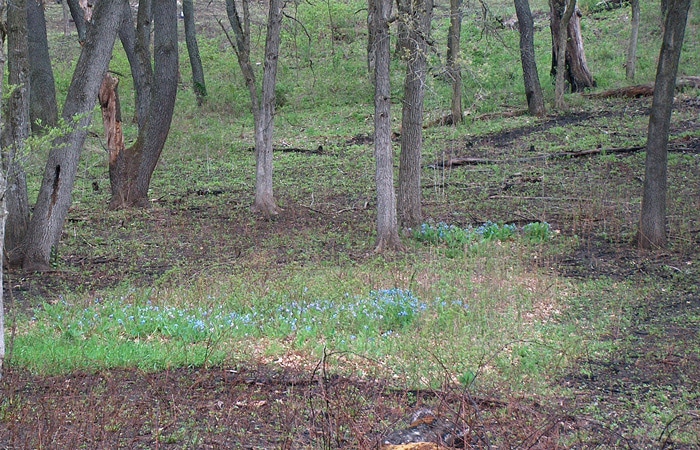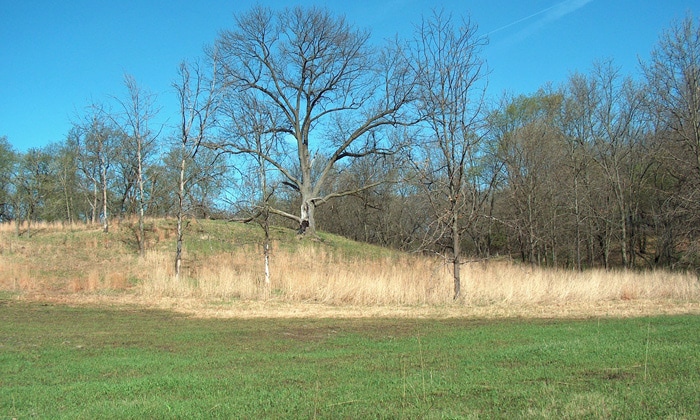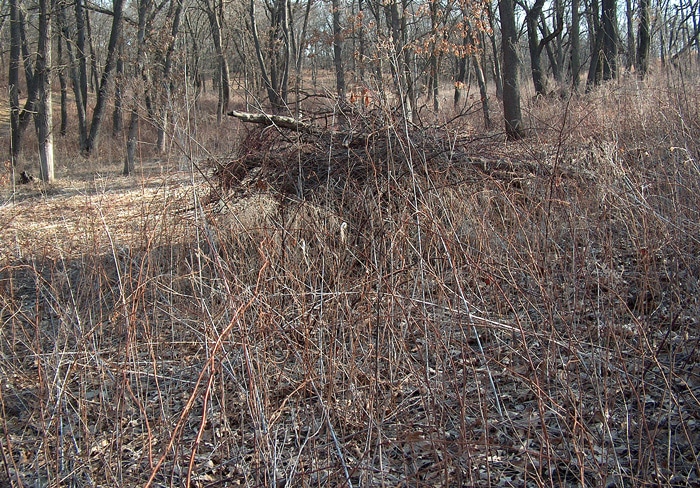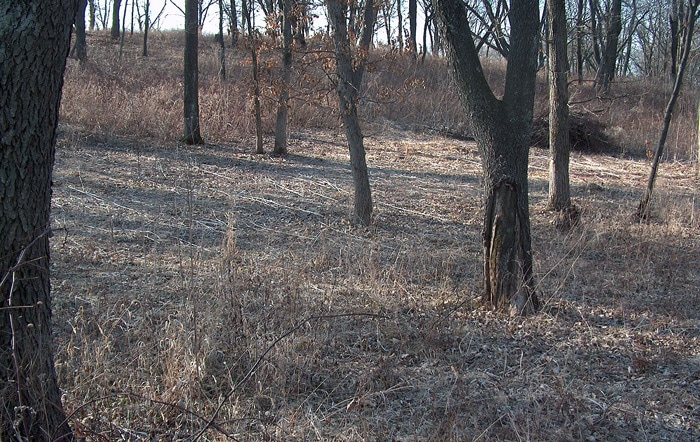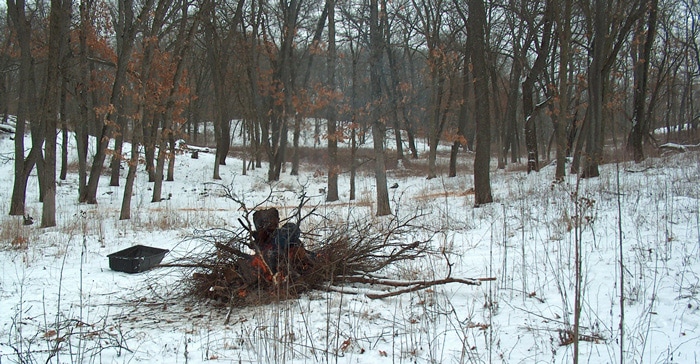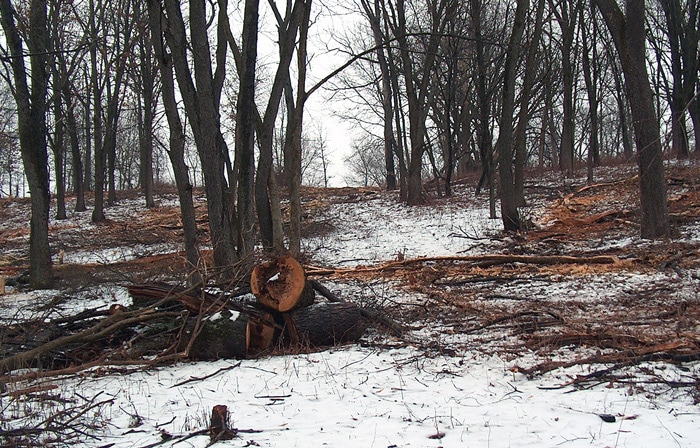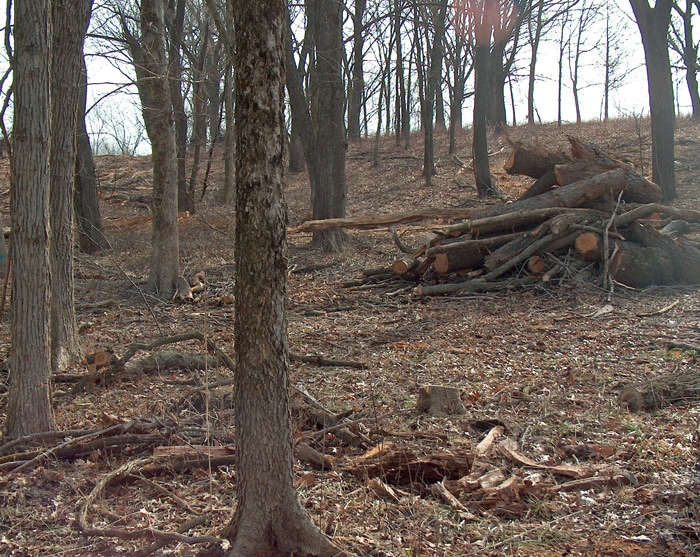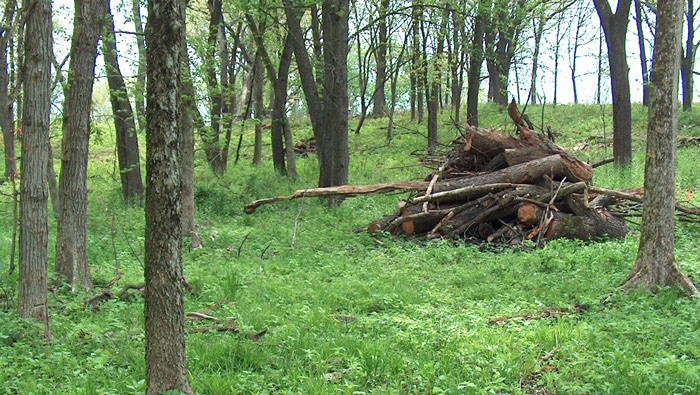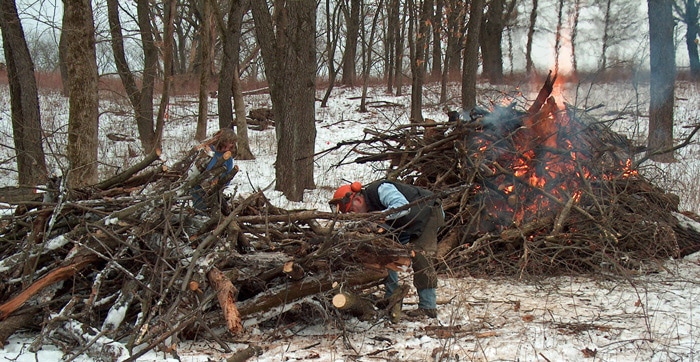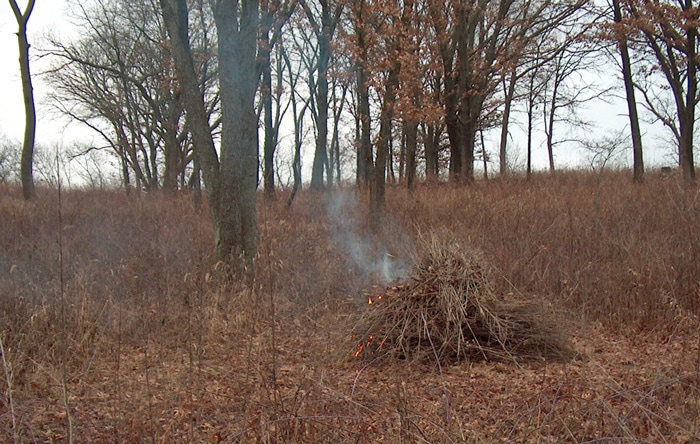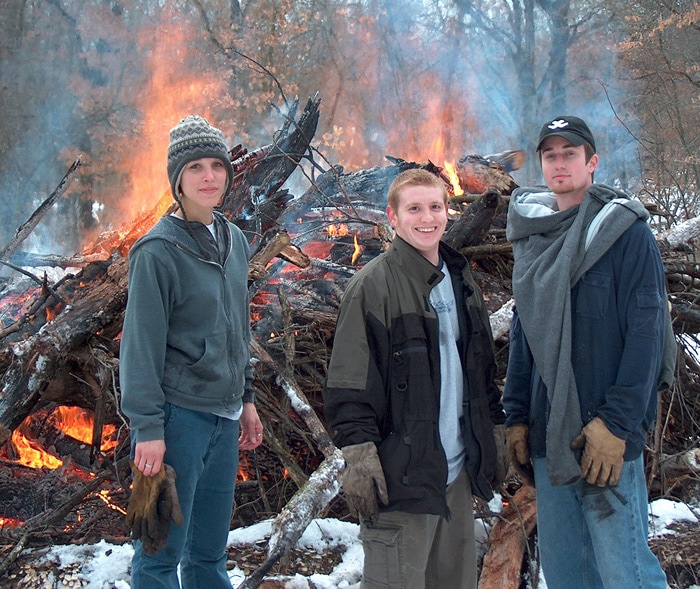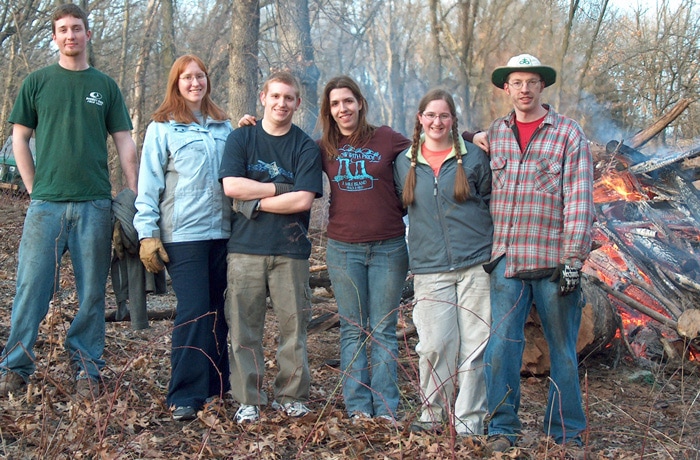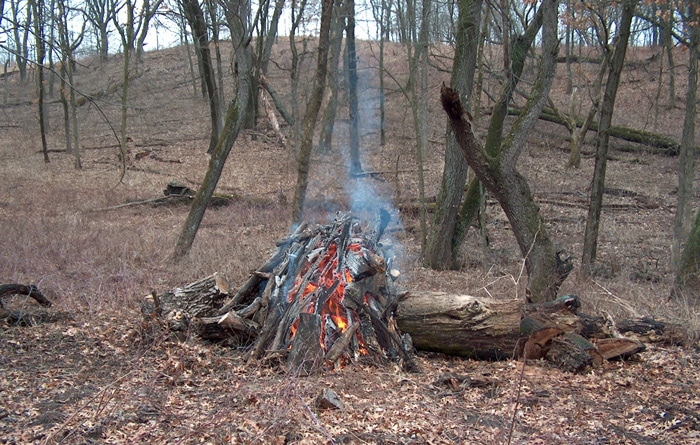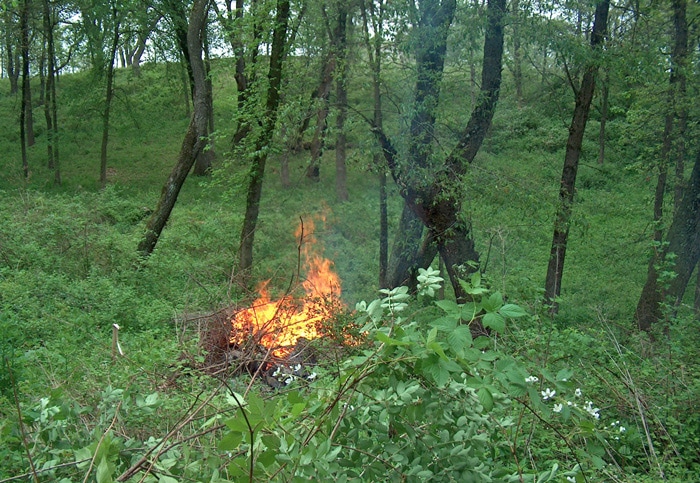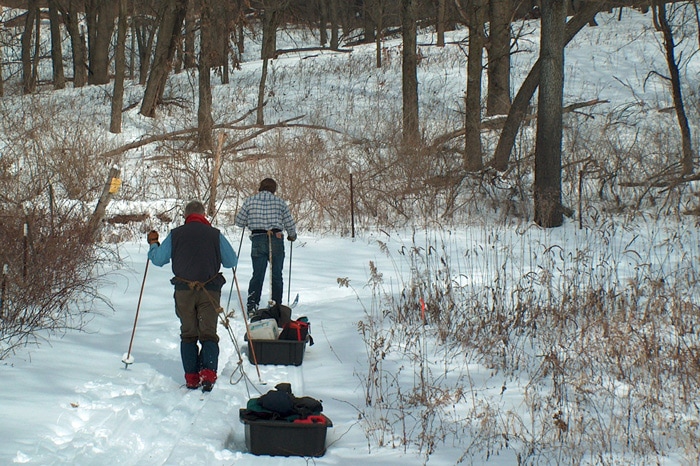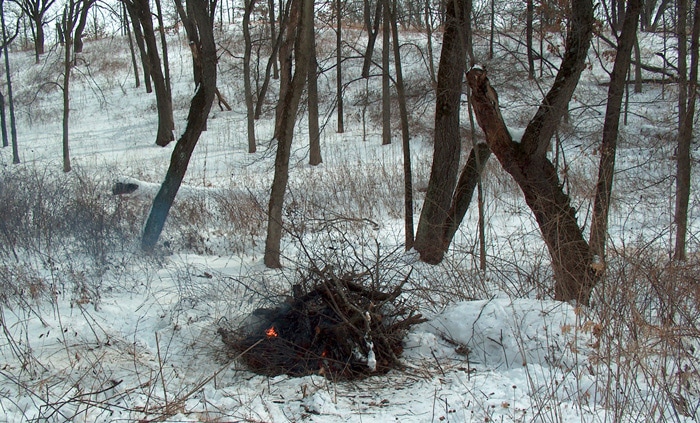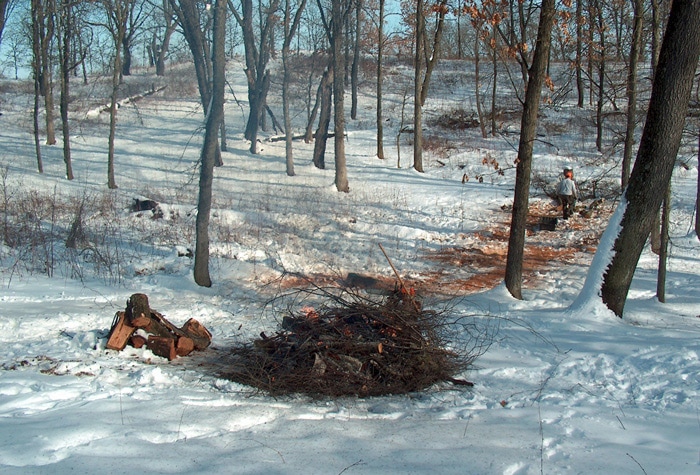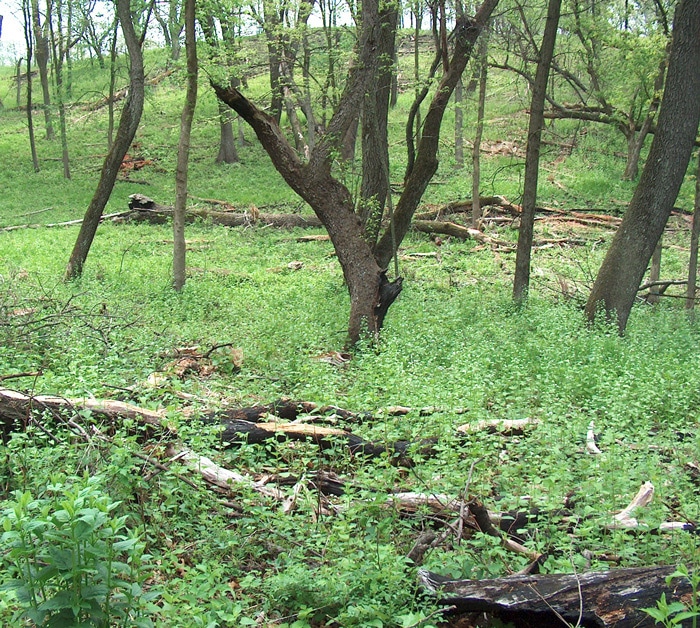Bluebell Valley Part 1
Bluebell Valley is named because there is a nice population of Mertensia virginica there. We did not begin any work there until after the forestry mower came in January 2004.
In 2004, we were still focusing on willow in the Sedge Meadow, fallen girdled cherries, and Lotus corniculata aka birdsfoot trefoil. This photo and the next two photos look south at Bluebell Valley from brush pile #9 which is at the west base of North Knob. At the left there is a double trunk tree creating a V. In the center background there are two trees creating a V. At the right foreground there are two trees one behind another. In general pay attention to how the background of photos changes over time and how much brush is removed.
The eastern boundary of Bluebell Valley is the western sides of North Knob, Middle Knob , the Saddle, and South Knob. As of February 2013 we have burned brush pile #9, west of North Knob, more times than any other location, 33 of the 297 workdays with bonfires.
The western boundary of Bluebell Valley is the western property boundary from Point 19 to Point 20. As you will see, much has been accomplished in Bluebell Valley but in 2013 it still looks too closed in from the brush pile #9 location. Can you see the same trees pointed out in 2002 photo?
The forestry mower worked in Big Woods in January 2004. About half a dozen Dicentra cucullaria were visible later that year. In 2007 Tan Fui Lian and Bob Inger helped us pick and plant more Dutchman’s britches seed here. Every year we try to add seed and/or corms around the existing plants.
Refer to the Hickory Hollow Section & Saddle Section for more photos of forestry mower trash which had to be picked up and burned. We had already worked in those areas so they were more of a priority than working here in 2004. Photo is of the eastern side of Bluebell Valley.
As of 2013, we still have a significant amount of wood chunks in Bluebell Valley which should be picked up and hauled away to a burn pile. The topography of Big Woods seems to encourage storm down drafts which cause limbs and trees to fall down regularly. Photo is of the eastern side of Bluebell Valley.
There are at least four distinct patches of Virginia Bluebells which probably used to be one gorgeous contiguous area. You can see the gaps in the next photo. After the forestry mower work, we were overwhelmed with trying to clear forestry mower trash from the areas where we had already worked. See sections SouthKnob, Hickory Hollow, and Saddle. The initial build of a burn pile (#13) in the middle of Bluebell Valley did occur in 2004 and is discussed in the next part of this section. We did not burn 13.1 until 2005. Photo above was taken from a point just north of 13.1 looking to the north. Foreground tree is an elm, which is not fire tolerant. To the left of it in the distance are a double trunk cherry and another small elm. At the northern edge of the closest bluebell patch there is a pair of trees which can also be recognized in the April 2006 photo which follows.
We focused first on cleaning up the bluebell patches. This is the same view as in April 2004 from #13 north through Bluebell Valley. The next part of this section discusses the activities from April 2004 until April 2006.
Bluebell Valley Part 2
Nathan Bremer of CPW (Committee for the Preservation of Wildlife at Northern Illinois University) is adding to the feeder pile (on the left) for burn pile 13.2 which is on the right. We use “feeder piles” to keep burn piles from getting too large. When the main pile is burned, material from the feeder pile is judiciously moved from the feeder to the main pile. Photo is looking north through Bluebell Valley.
The initial build of #13 was January 2004 and after having seen the bluebells blooming in April 2004 we were not very happy about this burn pile location. Ultimately we decided it would be too much work to move it and have continued to use this location. But as in other burn pile locations, we created feeder piles so as to minimize the burn scar. Hank Hartman and Chris Hauser transferred material to #13.2 from the feeder pile.
As you can imagine we were even less pleased to find two lonely bluebells at the south edge of this burn pile after the first two burns of burn pile #13. We wonder how many and when other individual plants may have been wiped out. Directly “beneath” the bluebells is a prairie trillium. How many trilliums can you see in this photo? In March 2013 we needed to use this burn pile location but could not because the snow was so deep we could not locate the burn pile precisely.
The group of bluebells at the lower left corner of 13.3 has in fact increased as we have carefully avoided burning on top of it.
Fortunately we had noticed the initial bluebell leaves growing late in March 2004. So we spent two or three days raking firebreaks around the patches so that they would not burn in the prescribed fire which was coming in a few days. The picture above and the last one in the section show the efforts to keep the bluebells from burning paid off. Note the small tree marked with a blue blaze at the base. Prescribed fire occurred April 4, 2004. Photo is to the east with #13 just off the right edge of the picture.
Prescribed fire also occurred late in 2005. We used the leaf blower and rakes to create firebreaks around cool season plants which were already up and growing in the savanna. In 2005, we figured out that using a leaf blower makes the task of creating a firebreak much easier. This is also the south patch of bluebells. The small tree with blue blaze at base is again visible.
Bluebell north after the prescribed fire in 2005. Note the unburned bluebells which appear happy to have not been burned. In a different area of Bluebell Valley there is a small area of Dutchman’s Britches which we also have fire protected when needed.
Spring was very late in 2006 so we managed to complete the prescribed fire before plants were growing. Prescribed fire in 2007 happened on April 15. So the savanna was not included in that burn. Next photo shows the ignition line east of North Knob and therefore east of the savanna area of Big Woods.
Bluebell Valley Part 3
Multiflora rose has diminished but not yet controlled in Bluebell Valley. Rubus sp. does very well when more sunlight becomes available. Within this area, the bluebell patches were the first priority for removing both species as well as a smaller amount of honeysuckle. This work began in small areas before we had removed most of the forestry mower chunks. Depending on where you are standing, it is not obvious just how much is cleared. Photo is from south of burn pile #13 to the north.
By the end of the winter of 2011 we were able to expand small brush–free areas so as to connect them. This was also true in several areas outside of Bluebell Valley. Looking at burn pile #13 from the north side on the same day as the previous photo is a very different picture.
The multiflora rose was especially tedious and unpleasant here, but Bluebell Valley was improved by 2013. Photo to the north from burn pile #13.
The next set of photos reviews the history of the burn pile viewed from west to east. The first photo is before #13 existed. As usual, the background is what to watch. Reference trees are the large cherry trunk on the right, the triple trunk cherry in the center and a tall single trunk cherry on top of the Saddle which is currently invisible. Other Sections have commented on the fact that Hitchcock, a large bur oak in Hickory Hollow is a highly visible landmark. Watch for Hitchcock to appear.
This photo is burn pile 13.1. Large cherry trunk on the right of 13.1 and Triple trunk at the left and east of 13.1.
Because we had so many projects already started in other areas, we ignored #13.1 for nearly a year. At the top of the hill just left of the foreground elm, the invisible crooked cherry appears.
As mentioned previously we tried to minimize this burn scar so for several months there was always a big secondary feeder pile. This is the first burn at this location. The feeder pile in shown in Section 2 for #13.2 is completely different stuff than this photo. There are two tree trunks at the left of the photo. The bulge on the left side of second one is “invisible cherry tree”.
None of the trees we have removed in Bluebell Valley have been more than 40 years old. Historically this area was not a dense woods of cherry trees. The cherry tree south of #13 is gone, however the cherry at the west edge of the Saddle is not gone and Hitchcock appears to the right of it. If you have read other sections you know that Hitchcock is over the Saddle and half way down into Hickory Hollow. Even so you can see a massive amount of its crown. There have been 23 days of burning at this location.
The Northern Illinois University Committee for the Preservation of Wildlife has served as co-stewards of Big Woods for many years. Three members of NIU CPW helped burn #13.1.
Bluebell Vallery Part 4
NIU CPW members also worked on burn pile #18 (western edge of Bluebell Valley). CPW returned on another day by themselves and built burn pile #19 (southwest corner of Bluebell Valley) by picking up forestry mower trash in the area of Point 20. Overall they scavenged a huge percentage of the forestry mower remains between Point 19 and Point 20 along the western edge of Bluebell Valley!
The large trunk chunk underneath this was too big to move so it became the base of #18.1. Burn pile # 18 gradually moves to the south (to the right side of the picture) in order to eventually dispose of this chunk.
This is the first day we removed honeysuckle to the west of the 2-track. We began clearing the area behind (west of) where I am standing in order to eventually build bison fence! This is #18.7. The chunk is still there hiding behind the blooming Rubus. The cherry snag is still ugly.
February 2011, was a regularly scheduled Big Woods Workday and there was so much snow that it was not possible to drive a vehicle to the unit. Nonetheless, Kevin Kaltenbach and Hank Hartman pulled equipment behind them in sleds while skiing in. The workday consisted of removing a cherry just south of #18.5.
The chunk did not burn easily. Here it is just to the right of the burn pile covered with lots of snow. In a later burn, we had a pumper unit with 40 gallons of water to make sure the burn did not get out of hand. At the end of the day the chunk was still burning, so to be safe, I sprayed it with at least 20 gallons of water. Photo looks to the east from #18.5.
The most interesting thing about the burn pile photos is watching the background around the burn pile change. The previous photo shows the same area as the photo above but with several trees and lots of rubus missing. Note that the chunk is also gone. Burn pile #18.13.
Just for reference, the photo above is of the same area as the two previous photos, but was taken before we did any work in the area.
